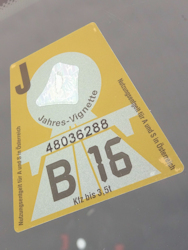
As a mild-mannered social democracy, Austria gives its citizens a lot of things for free. But motorways (German: Autobahn) are not one of them.
We have a toll system here, and visitors to the country are not exempt. Not even if you ask nicely.
- Physical or digital toll sticker required for motorway driving
- Annual, 2-month, 10-day & 1-day stickers available
- Physical tickets sold at numerous outlets
- Some additional toll roads in the mountains
- Compare car hire options* for Vienna
- See also:
How do the tolls work?
The general toll system has no booths or barriers collecting payments. Instead, you need to buy a physical or digital toll sticker (German: Vignette or Autobahnpickerl) before driving on a motorway or expressway with a car or motorcycle.
Heavier vehicles over 3.5t maximum permissible weight, such as buses, lorries etc., use a completely different toll system.
Option 1 – physical toll sticker
If you enter Austria on a toll road, you’ll get the opportunity to purchase a sticker at the border.
Inside the country, various places sell the sticker, including newsagents (Trafik), the automobile associations, and special outlets of the public agency responsible for expressways and motorways (ASFINAG). The sticker only becomes valid if affixed to the vehicle.
Cars hired in Austria* should already have a toll sticker in place – but check, of course.
Here’s an annual Vignette from a while back. The colour changes each year:

(An old Vignette)
Toll prices
In 2025, an annual toll sticker costs €103.80 for a car.
The annual vignette remains valid for fourteen months: from December 1st of the preceding year to January 31st of the following one. So a 2025 annual toll sticker (once displayed properly) applies from December 1st, 2024 to January 31st, 2026.
You can get short-term stickers, too, if you’re not planning to stay that long. A 2-month car sticker in 2025 costs €31.10, and a 10-day sticker €12.40. Note that these two stickers need to be punched at the point of sale to be valid. A 1-day vignette costs €9.30 but is only available digitally (see below).
Prices for motorcycles in 2025 are €41.50, €12.40, €4.90 and €3.70 respectively.
Where to put the sticker
Clearly display the sticker inside your car windscreen. The authorities recommend you place it near the rear-view mirror or the top-left corner as you face out of the car.
Don’t throw away the sticker back – you may need it as proof of purchase.
Motorcycles should affix the sticker to somewhere clean and permanent.
Option 2 – a digital Vignette
ASFINAG also offer a digital option, where you pay online and associate a car number plate with your payment. Prices are as above. Note that the annual and 2-month digital vignettes are not activated straightaway if you’re a private person (see the website for more information).
No physical sticker is involved – the authorities have a record of your toll payment should they check your car. If buying the digital 2-month, 10-day or 1-day options, you also need to specify a starting date.
If you’re unsure if your hired car has a digital toll sticker, check the number plate at the ASFINAG website.
How do I know when I need a Vignette?
The Vignette is required when you travel by car or motorbike on pretty much any motorway or expressway in Austria. These roads should be obvious, but look for signs like the below to indicate you need a toll sticker to travel on this road:

(The top text says a Vignette toll sticker is obligatory for vehicles up to 3.5t.)
Even if you’re just driving around Vienna, you may still need to buy a Vignette, since expressways and motorways do pass through the city.
A tiny handful of stretches of motorway remain exempt from the toll obligation, but none of them are anywhere near Vienna.
Section tolls
A very few major roads and tunnels crossing the Alps are subject to an independent toll.
You can pay the fee in person at the entrance to the relevant section or pay online at the same site selling the standard digital toll stickers. None of these special toll roads are close to Vienna, either, since the Alps only start to the west of the city.
What about…?
For the fine print of the motorway toll requirements and answers to various other related questions, see the official Vignette page at ASFINAG, which has a full English-language version.
P.S. Many of Austria’s immediate neighbours also have some kind of toll system for cars and motorways, including (at the time of writing) Slovenia, Switzerland, Italy, Hungary, Czechia, and Slovakia.
